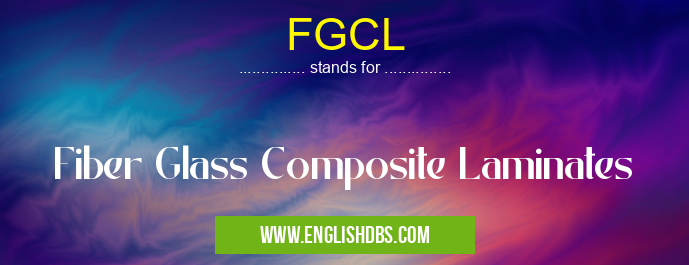What does FGCL mean in UNCLASSIFIED
Fiber Glass Composite Laminates, or FGCL, are a strong and versatile material used in many modern engineering and construction applications. FGCL is made out of fiberglass composite sheets that are laminated together using an adhesive. This gives the material a great deal of strength and resistance to harsh environments, making it ideal for use in areas where durability is needed. It can also be customized to meet specific requirements for shape, size and tolerance, making it highly versatile for many different applications.

FGCL meaning in Unclassified in Miscellaneous
FGCL mostly used in an acronym Unclassified in Category Miscellaneous that means Fiber Glass Composite Laminates
Shorthand: FGCL,
Full Form: Fiber Glass Composite Laminates
For more information of "Fiber Glass Composite Laminates", see the section below.
Properties and characteristics
FGCL is incredibly strong because it combines the strength of glass fibers with bonding agents to create reinforced sheeting with superior properties. The strength comes from the inter-laminate bond which also provides flexibility while still being lightweight. FGCL can also resist weathering due to its waterproof nature and UV resistant coating that can help protect against corrosion. Additionally, its lightweight nature makes it much easier to handle and transport than heavier materials such as steel or aluminum.
Applications
Due to its versatility and strength, FGCL has been widely adopted by multiple industries including automotive, aerospace, marine and construction sectors. In the automotive sector it is widely used to manufacture car bodies; in aerospace for airframes; marine for boats; and construction for a variety of projects such as cladding walls or roofs. Its ability to withstand extreme temperatures as well as temperature fluctuations make it popular for industrial applications such as machine parts or motors.
Benefits
FGCL offers a number of advantages over other materials such as cost effectiveness, weather resistance, light weight structure along with high thermal performance when compared to traditional materials like steel or aluminum which makes FGCL suitable for applications requiring lightweight components that are durable enough to withstand any type of conditions over time without degrading too quickly in quality or performance. Additionally, FGCL can be customised into intricate shapes easily compared with traditional materials therefore giving engineers more design freedom when creating structures or components.
Essential Questions and Answers on Fiber Glass Composite Laminates in "MISCELLANEOUS»UNFILED"
What is the purpose of using Fiber Glass Composite Laminates?
Fiber Glass Composite Laminates (FGCL) are used in a variety of applications, from boat hulls and aircraft components to aerospace components and industrial structures. FGCL are lightweight and high-strength laminates composed of multiple layers of glass fibers impregnated with resin. These laminates offer superior strength, durability, thermal stability, chemical resistance and electrical insulation to many other materials.
What are the advantages of FGCL compared to other composite materials?
FGCL offer excellent environmental performance with low toxicity levels, high fatigue resistance over wide temperature ranges, as well as good strength-to-weight ratio. They also have very low expansion or contraction when exposed to changes in temperature or humidity.
How strong is FGCL?
FGCL provide superior strength compared to many metal alloys and can be further optimized by increasing the number of layers used during the manufacturing process. Depending on the application, a standard FGCL laminate could have tensile strengths up to 700MPa (megapascals).
What types of properties do FGCL possess?
As a composite material, FGCL offers excellent physical properties such as high strength-to-weight ratio, low moisture absorption rates, good abrasion resistance and stiffness. Additionally, these laminates are also resistant to most acids and can withstand severe thermal impacts without delamination or cracking.
What types of applications can benefit from using FGCL?
Common applications that benefit from utilizing FGCL include aircraft wings, interior parts for vehicle bodies and frames for naval vessels among others due to their lightweight yet great strength qualities. Additionally, FGCL products may also be used in structural support systems and protective coatings within shipyards or other industrial settings requiring superior corrosion protection.
How are composite laminates fabricated?
The fabrication process typically involves layering individual sheets made out of woven glass fabric or matting within molded molds under pressure while combined with resins that act as adhesives between them. Depending on its complexity the production process for each finished product may range from several hours up to several days depending on its application requirements.
What places can I find more information about FGLC?
In addition to searching through public domain websites such as Wikipedia for general information regarding fiberglass composites there are various manufacturers who specialize in manufacturing this type of material located worldwide that may provide technical details about product specifications upon request.
